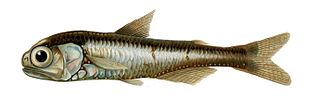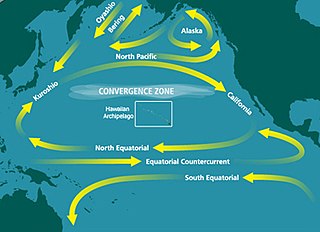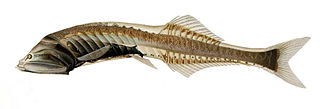
Deep-sea fish are fish that live in the darkness below the sunlit surface waters, that is below the epipelagic or photic zone of the sea. The lanternfish is, by far, the most common deep-sea fish. Other deep-sea fishes include the flashlight fish, cookiecutter shark, bristlemouths, anglerfish, viperfish, and some species of eelpout.
The pelagic zone consists of the water column of the open ocean and can be further divided into regions by depth. The word pelagic is derived from Ancient Greek πέλαγος (pélagos) 'open sea'. The pelagic zone can be thought of as an imaginary cylinder or water column between the surface of the sea and the bottom. Conditions in the water column change with depth: pressure increases; temperature and light decrease; salinity, oxygen, micronutrients all change. Somewhat analogous to stratification in the Earth's atmosphere, but depending on how deep the water is, the water column can be divided vertically into up to five different layers.
The mesopelagiczone, also known as the middle pelagic or twilight zone, is the part of the pelagic zone that lies between the photic epipelagic and the aphotic bathypelagic zones. It is defined by light, and begins at the depth where only 1% of incident light reaches and ends where there is no light; the depths of this zone are between approximately 200 to 1,000 meters below the ocean surface.
The bathypelagic zone or bathyal zone is the part of the open ocean that extends from a depth of 1,000 to 4,000 m below the ocean surface. It lies between the mesopelagic above and the abyssopelagic below. The bathypelagic is also known as the midnight zone because of the lack of sunlight; this feature does not allow for photosynthesis-driven primary production, preventing growth of phytoplankton or aquatic plants. Although larger by volume than the photic zone, human knowledge of the bathypelagic zone remains limited by ability to explore the deep ocean.

Lanternfish are small mesopelagic fish of the large family Myctophidae. One of two families in the order Myctophiformes, the Myctophidae are represented by 246 species in 33 genera, and are found in oceans worldwide. Lanternfishes are aptly named after their conspicuous use of bioluminescence. Their sister family, the Neoscopelidae, are much fewer in number but superficially very similar; at least one neoscopelid shares the common name "lanternfish": the large-scaled lantern fish, Neoscopelus macrolepidotus.

Pelagic fish live in the pelagic zone of ocean or lake waters—being neither close to the bottom nor near the shore—in contrast with demersal fish that live on or near the bottom, and reef fish that are associated with coral reefs.

A viperfish is any species of marine fish in the genus Chauliodus. Viperfishes are mostly found in the mesopelagic zone and are characterized by long, needle-like teeth and hinged lower jaws. A typical viperfish grows to lengths of 30 cm (12 in). Viperfishes undergo diel vertical migration and are found all around the world in tropical and temperate oceans. Viperfishes are capable of bioluminescence and possess photophores along the ventral side of their body, likely used to camouflage them by blending in with the less than 1% of light that reaches to below 200 meters depth.

Maurolicus muelleri, commonly referred to as Mueller's pearlside,Mueller's bristle-mouth fish, or the silvery lightfish, is a marine hatchetfish in the genus Maurolicus, found in deep tropical, subtropical and temperate waters of the Pacific Ocean and the Atlantic Ocean, from the surface to depths of 1,500 metres (4,900 ft). It can grow to a maximum total length of 8 centimetres (3.1 in).

The giant oarfish is a species of oarfish of the family Regalecidae. It is an oceanodromous species with a worldwide distribution, excluding polar regions. Other common names include Pacific oarfish, king of herrings, ribbonfish, and streamer fish.

The blackbelly lanternshark or lucifer shark, Etmopterus lucifer, is a shark of the family Etmopteridae, found around the world in tropical to temperate seas, at depths between 150 and 1,250 meters. Its length is up to 47 centimeters. This species consumes mesopelagic cephalopods, fishes, and crustaceans.

The fringefin lanternshark is a shark of the family Etmopteridae found in the western central Atlantic from Texas to Florida, northern Gulf of Mexico, and Mexico. It is endemic to this area. It is a deep water shark and is found about 220 to 915 meters below the surface, on the upper continental slopes of the Gulf. E. schultzi is a small shark, about 27–30 cm long and feeds on squid. It is also bioluminescent, which counter-illuminates it and helps with intraspecific interaction. Due to its limited range and the difficulty of collecting deep water species, it has not been evaluated by the IUCN Red List, but due to recent oil spills in the Gulf of Mexico, it is likely that fringefin lanternsharks have decreased in population.

The North Pacific Subtropical Gyre (NPSG) is the largest contiguous ecosystem on earth. In oceanography, a subtropical gyre is a ring-like system of ocean currents rotating clockwise in the Northern Hemisphere and counterclockwise in the Southern Hemisphere caused by the Coriolis Effect. They generally form in large open ocean areas that lie between land masses.

Cyclothone is a genus containing 13 extant species of bioluminescent fish, commonly known as 'bristlemouths' or 'bristlefishes' due to their shared characteristic of sharp, bristle-like teeth. These fishes typically grow to around 1-3 inches, though some can be larger. They are most commonly found in the mesopelagic zone of the ocean, mostly at depths of over 300 meters, and many species have bioluminescence.

Ribes sericeum is a species of currant known by the common name Lucia gooseberry, or Santa Lucia gooseberry; its Latin epithet of sericeum means "of silk". It is endemic to California, where it is known only from the Santa Lucia Mountains along the Central Coast and an additional isolated population in Santa Barbara County.

Counter-illumination is a method of active camouflage seen in marine animals such as firefly squid and midshipman fish, and in military prototypes, producing light to match their backgrounds in both brightness and wavelength.
The black snake mackerel is a species of snake mackerel found worldwide in both tropical and temperate waters where they are found at depths of from 914 to 1,646 metres making diel vertical migrations from mesopelagic depths to the surface at night. It can reach a length of 25 centimetres (9.8 in) SL though most do not exceed 15 centimetres (5.9 in) SL. It is important to local peoples as a food fish. This species is currently the only known member of its genus, Nealotus. That genus is therefore said to be monotypic.

Galiteuthis glacialis is a species of glass squid from the Antarctic Convergence. It is in the cranchiidae family and subfamily taoniinae. They are endemic to the Antarctic and are found in the Southern Ocean, around the Weddell Sea and the South Shetland Islands. Galiteuthis glacialis are one of the most plentiful and widely dispersed species of Antarctic squid. These squids are found in the mesopelagic and bathypelagic layers of the open ocean and demonstrate vertical migration. They can reach a maximum mantle length of 500 mm (0.5m).
Dictyonema hernandezii is a species of basidiolichen in the family Hygrophoraceae. Found in montane rainforests of Costa Rica and in Colombia, it was described as new to science in 2011. The specific epithet hernandezii honours Venezuelan lichenologist Jesús Hernández.

Neoscopelus macrolepidotus, also known as a large-scaled lantern fish, is a species of small mesopelagic or bathypelagic fish of the family Neoscopelidae, which contains six species total along three genera. The family Neoscopelidae is one of the two families of the order Myctophiformes. Neoscopelidae can be classified by the presence of an adipose fin. The presence of photophores, or light-producing organs, further classify the species into the genus Neoscopelus. N. macrolepidotus tends to be mesopelagic until the individuals become large adults, which is when they settle down to the bathypelagic zone.
A micronekton is a group of organisms of 2 to 20 cm in size which are able to swim independently of ocean currents. The word 'nekton' is derived from the Greek νήκτον, translit. nekton, meaning "to swim", and was coined by Ernst Haeckel in 1890.















